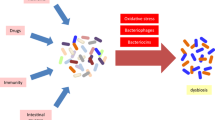Abstract
To define the action of deconjugated bile acids on the small intestinal permeability in an in vitrosystem, we investigated the effects of chenodeoxycholic acid and ursodeoxycholic acid on the rate of transmural flux of lactulose in jejunal and ileal mucosa of rabbits, stripped of their muscle layers and mounted in Ussing chambers. In a series of experiments, tissue samples from small intestinal segments either exposed to bile acids or not also were examined by scanning and transmission electron microscopy to study the integrity of the tight junctions. Results show that chenodeoxycholate, starting at the concentration of 0.1 mM, enhanced in a doserelated manner the trans epithelial flux of lactulose in the ileum. Both chenodeoxycholate (0.5 mM) and ursodeoxycholate (0.5 mM) significantly increased mucosal permeability to lactulose in jejunum and ileum; the effect of chenodeoxycholate was also shown to be reversible, as it completely disappeared within 40 min after its withdrawal and it did not result in permanent changes of epithelial transport function. Finally, the tight junctions appeared loosened by the addition of 1 mM chenodeoxycholate, suggesting that this is the major site of the transient bile acid increase of small intestinal permeability to compounds such as lactulose, having a molecular radius wider than 0.5 nm.
Similar content being viewed by others
References
Karlqvist PA, Franzen L, Sjodahl R, Tagesson C: Lysophosphatidylcholine and taurodeoxycholate increase stomach permeability to different-sized molecules. Scan J Gastroenterol 21:1039–1045, 1986
Fagundes-Neto U, Teichberg S, Bayne MA, Morton B, Lifschitz F: Bile salt-enhanced rat jejunal absorption of a macromolecular trace. Lab Invest 44:18–25, 1981
Binder HJ, Dobbins JW, Racusen LC, Whiting DS: Effect of propranolol on ricinoleic acid- and deoxycholic acid-induced changes of intestinal electrolyte movement and mucosal permeability. Gastroenterology 75:668–673, 1978
Freel RW, Hatch M, Earnest DL, Goldner AM: Role of tight-junctional pathways in bile salt-induced increases in colonic permeability. Am J Physiol 245:G816-G823, 1983
Northfleld TC, McColl I: Postprandial concentrations of free and conjugated bile acids down the length of the normal human small intestine. Gut 14:513–518, 1973
Rosenberg IH, Hardison WG, Bull DM: Abnormal bile-salt patterns and intestinal bacterial overgrowth associated with malabsorption. N Engl J Med 277:1391–1397, 1967
Budillon G, Parrilli G, D'Agostino L, Capuano G, Mazzacca G, Menzies IS: Cholecystokinin and human intestinal permeability. Digestion 20:68–72, 1980
Budillon G, Parrilli G, Capuano G, Mazzacca G, Menzies IS: The cholecystokinin effect on human intestinal permeability: Influence of chenodeoxycholic acid and ursodeoxycholic acid administration. Digestion 24:274–280, 1982
Guandalini S, Kachur JF, Smith PL, Field M: Somatostatin effects on ion transport in rabbit intestine. Am J Physiol 240:G26-G32, 1980
Field M, McColl I: Ion transport in rabbit ileal mucosa. I. Na and Cl fluxes and short-circuit current. Am J Physiol 220:1388–1396, 1971
Laker MF: Estimation of disaccharides in plasma and urine by gas liquidchromatography. J Chromatogr 163:9–18, 1979
Mooney SM, Loretz CA: Differential effects of two bile salts on ion transport characteristics of teleost intestine. Comp Biochem Physiol 86A:367–372, 1987
Erickson RA, Tarnawski A, Krause WJ: 16, 16-Dimethyl prostaglandin E2 reduces chenodeoxycholate-induced small intestinal mucosal injury in the rat. J Clin Lab Med 110:387–394, 1987
Saunders DR, Hedges JR, Silery J, Esther L, Matsura K, Rubin CE: Morphological and functional effects of bile salts in rat colon. Gastroenterology 68:1236–1245, 1975
Rampton DS, Breuer NF, Vaja SG, Sladen GE, Dowling RH: Role of prostaglandins in bile salt-induced changes in rat colonic structure and function. Clin Sci 61:641–648, 1981
Teem MV, Phillips SF: Perfusion of the Hamster jejunum with conjugated and unconjugated bile acids: Inhibition of water absorption and effects on morphology. Gastroenterology 62:261–267, 1972
Binder HJ, Filburn C, Volpe BT: Bile salt alteration of colonic electrolyte transport: role of cyclic adenosine monophosphate. Gastroenterology 68:503–508, 1975
Hardison WGM, Bellantani S, Heasley V, Shellhamer J: Specificity of a Na+ dependent taurocholate transport site in isolated rat hepatocytes. Am J Physiol 246:G477-G483, 1984
Lester R, Pyrek SJ, Little JM, Adcock EW: What is meant by the term “bile acids”? Am J Physiol 245:G816-G823, 1983
Maxtond DG, Bjarnason I, Reynolds AP, Catt SD, Peters TJ, Menzies IS: Lactulose,51Cr-labelled ethylenediami-notetra-acetate, L-rhamnose and polyethylene-glycol 500 as probe markers for assessmentin vivo of human intestinal permeability. Cli Sci 71:71–80, 1986
Nissim JA: Reduction of intestinal absorption by a synthetic chemical. Nature 185:222–224, 1960
Stevenson BR, Anderson JM, Bullivant S: The epithelial tight junction: Structure, function and preliminary biochemical characterization. Mol Cell Biochem 83:129–145, 1988
Gumbiner B: The structure, biochemistry, and assembly of epithelial tight junctions. Am J Physiol 253:C749-C758, 1987
Madara JL: Tight junction dynamics: is the paracellular pathway regulated? Cell 53:497–498, 1988
Madara JL: Perspectives. Loosening tight junctions. Lessons from the intestine. J Clin Invest 83:1089–1094, 1989
Stevenson BR, Goodenough DA: Zonulae occludentes in junctional complex-enriched fractions from mouse liver. Preliminary morphological and biochemical characterization. J Cell Biol 98:1209–1221, 1984
Citi S, Sabanay H, Jakes R, Geiger B, Kendrick-Jones J: Cingulin, a peripheral component of tight junctions. Nature 332:272–276, 1988
Pappenheimer JR, Reiss KZ: Contribution of solvent drag through intercellular junctions to absorption of nutrients by the small intestine of the rat. J Membr Biol 100:123–136, 1987
Author information
Authors and Affiliations
Rights and permissions
About this article
Cite this article
Fasano, A., Budillon, G., Guandalini, S. et al. Bile acids reversible effects on small intestinal permeability. Digest Dis Sci 35, 801–808 (1990). https://doi.org/10.1007/BF01536791
Received:
Revised:
Accepted:
Issue Date:
DOI: https://doi.org/10.1007/BF01536791




